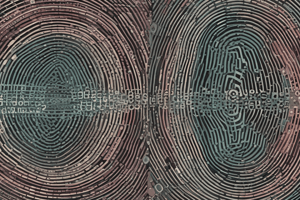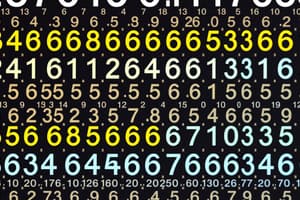Podcast
Questions and Answers
What is the formula for an arithmetic sequence?
What is the formula for an arithmetic sequence?
- an = a1 × r^(n-1)
- an = an-1 + 2n - 1
- an = a1 / (n-1)
- an = a1 + (n-1)d (correct)
What is the common characteristic of an arithmetic sequence?
What is the common characteristic of an arithmetic sequence?
- Each term is obtained by adding a fixed constant to the previous term. (correct)
- Each term is obtained by subtracting a fixed constant from the previous term.
- Each term is obtained by multiplying the previous term by a fixed constant.
- Each term is obtained by adding a fixed constant to the square of the previous term.
What is the formula for a geometric sequence?
What is the formula for a geometric sequence?
- an = an-1 + 2n - 1
- an = a1 + (n-1)d
- an = a1 / (n-1)
- an = a1 × r^(n-1) (correct)
What is the purpose of visual representations, such as number lines or graphs, in identifying number patterns?
What is the purpose of visual representations, such as number lines or graphs, in identifying number patterns?
What is the common characteristic of a quadratic sequence?
What is the common characteristic of a quadratic sequence?
What is the formula for a quadratic sequence?
What is the formula for a quadratic sequence?
What is one of the real-world applications of number patterns?
What is one of the real-world applications of number patterns?
What is the first step in identifying a number pattern?
What is the first step in identifying a number pattern?
Flashcards are hidden until you start studying
Study Notes
Number Patterns
A number pattern is a sequence of numbers that follow a specific rule or relationship.
Types of Number Patterns:
- Arithmetic Sequence: A sequence of numbers in which each term is obtained by adding a fixed constant to the previous term.
- Example: 2, 5, 8, 11, 14...
- Formula: an = a1 + (n-1)d, where an is the nth term, a1 is the first term, and d is the common difference.
- Geometric Sequence: A sequence of numbers in which each term is obtained by multiplying the previous term by a fixed constant.
- Example: 2, 6, 18, 34, 50...
- Formula: an = a1 × r^(n-1), where an is the nth term, a1 is the first term, and r is the common ratio.
- Quadratic Sequence: A sequence of numbers in which each term is obtained by adding a fixed constant to the square of the previous term.
- Example: 1, 4, 9, 16, 25...
- Formula: an = an-1 + 2n - 1, where an is the nth term.
Identifying Number Patterns:
- Look for a consistent difference or ratio between consecutive terms.
- Check if the sequence follows a specific formula or relationship.
- Use visual representations, such as number lines or graphs, to help identify patterns.
Real-World Applications:
- Number patterns are used in finance to calculate interest rates and investment returns.
- They are used in science to model population growth and chemical reactions.
- They are used in computer programming to write algorithms and solve problems.
Tips and Tricks:
- Start by identifying the type of sequence (arithmetic, geometric, or quadratic).
- Use the formula to find the next term or to identify the pattern.
- Practice solving different types of number patterns to improve your skills.
Number Patterns
- A number pattern is a sequence of numbers that follow a specific rule or relationship.
Types of Number Patterns
- Arithmetic Sequence: Each term is obtained by adding a fixed constant to the previous term.
- Example: 2, 5, 8, 11, 14...
- Formula: an = a1 + (n-1)d, where an is the nth term, a1 is the first term, and d is the common difference.
- Geometric Sequence: Each term is obtained by multiplying the previous term by a fixed constant.
- Example: 2, 6, 18, 34, 50...
- Formula: an = a1 × r^(n-1), where an is the nth term, a1 is the first term, and r is the common ratio.
- Quadratic Sequence: Each term is obtained by adding a fixed constant to the square of the previous term.
- Example: 1, 4, 9, 16, 25...
- Formula: an = an-1 + 2n - 1, where an is the nth term.
Identifying Number Patterns
- Look for a consistent difference or ratio between consecutive terms.
- Check if the sequence follows a specific formula or relationship.
- Use visual representations, such as number lines or graphs, to help identify patterns.
Real-World Applications
- Number patterns are used in finance to calculate interest rates and investment returns.
- They are used in science to model population growth and chemical reactions.
- They are used in computer programming to write algorithms and solve problems.
Tips and Tricks
- Identify the type of sequence (arithmetic, geometric, or quadratic) to start solving.
- Use the formula to find the next term or to identify the pattern.
- Practice solving different types of number patterns to improve skills.
Studying That Suits You
Use AI to generate personalized quizzes and flashcards to suit your learning preferences.




